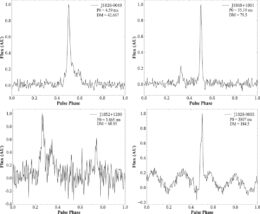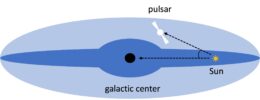A pilot survey using the world’s largest radio dish has led to the discovery of four pulsars, two of which are ultra-precise millisecond pulsars. This survey highlights the wealth of pulsars that await discovery at intermediate galactic latitudes.
Small Stars with a Big Impact

An artist’s impression of a pair of pulsars. [Michael Kramer (Jodrell Bank Observatory, University of Manchester)]
Several thousand pulsars have been discovered in our galaxy, but there’s a need to find even more: pulsars provide a path to studying stellar evolution, the interiors of neutron stars, and even gravitational waves. Millisecond pulsars — those with the shortest rotation periods, around 10 milliseconds or less — are especially precious, as their pulses are exceptionally regular. By monitoring the arrival times of the pulses from many millisecond pulsars at once, researchers have found evidence for the gravitational wave background, which is thought to be the combined signals of millions of distant supermassive black hole binaries.
A Small FAST Survey
Where and how do we find pulsars? The word pulsar is short for pulsating radio source, and most pulsars are identified in surveys by their characteristic pulses of radio emission. Like most stars, pulsars are concentrated in the thin disk of our galaxy, but interstellar clouds of gas and dust in this region can scatter pulsar signals. Searching the area just above the galactic plane makes for easier pulsar discovery, and current evidence suggests that millisecond pulsars may be more common in these higher-latitude regions.
Using the Five-hundred Aperture Spherical Telescope (FAST) — the world’s largest radio dish — Qijun Zhi (Guizhou Normal University) and collaborators searched for pulsars in a small area of the sky about 5 degrees above the galactic midplane. The survey discovered four new pulsars and recovered all seven of the known pulsars in the search area. Of the four newly discovered pulsars, two are of the coveted millisecond variety, with rotation periods of 3.9 and 4.6 milliseconds. One of these two millisecond pulsars especially warrants further study, since it is bright enough to possibly be included in pulsar timing arrays in the future.More Pulsars to Come
The pilot survey described in this study complements the efforts of other pulsar surveys. FAST is currently at work on the Commensal Radio Astronomy FAST Survey and the Galactic Plane Pulsar Survey, both of which aim to find pulsars at galactic latitudes below 10 degrees. These surveys have led to the discovery of roughly 800 pulsars so far, about 200 of which are millisecond pulsars.Zhi and collaborators expect that many more pulsars await discovery at intermediate galactic latitudes, 5 to 15 degrees above the midplane of the Milky Way. Considering the success of their limited pilot study, the team expects that roughly 900 millisecond pulsars could be found in that region.
Citation
“Discovery of Four Pulsars in a Pilot Survey at Intermediate Galactic Latitudes with FAST,” Q. J. Zhi et al 2024 ApJ 960 79. doi:10.3847/1538-4357/ad0eca


